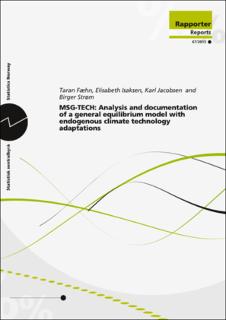MSG-TECH: Analysis and documentation of a general equilibrium model with endogenous climate technology adaptations
Report
Permanent lenke
https://hdl.handle.net/11250/3119694Utgivelsesdato
2013-10Metadata
Vis full innførselSamlinger
- Rapporter / Reports (SSB) [1689]
Sammendrag
To meet the global challenge of climate change, shifts in industrial structures and
consumption patterns will have to be accompanied by technological adaptations.
Analytical tools for projecting effects of ambitious climate policies cannot be based
on historical data and current technology characteristics, alone, but need to represent technological innovations that have not yet emerged. This is the background
for the development of the hybrid model MSG-TECH, which builds on the computable general equilibrium (CGE) model MSG6, but resembles energy system
models in its inclusion of anticipated future technological options. The information
on technological options is collected from bottom-up calculations and is exploited
to model a wider range of possibilities in the optimisation by households, firms,
and public institutions than in traditional CGE models.
The significance of the modelling innovations is illustrated by introducinga uniform carbon price to achieve the same climate policy target – a cut of 10 million
tons CO2 equivalents by 2020 - in the MSG-TECH model and the original MSG6
model, respectively. When technological adaptations are accounted for, over one
half of the necessary reductions take place by choosing other technological solutions. When these options are left out, marginal abatement costs more than triple
and welfare costs more than quadruple, and the cost increase for the traditional
manufacturing industries is particularly severe.The intuition is that a model that
fails to account for a large part of the expected future abatement alternatives reflects an unrealistically inflexible and inefficient economy. The corresponding
characteristic would apply to traditional bottom-up models that include technological abatement, but fail to account for reduced economic activity and new industrial
patterns.

